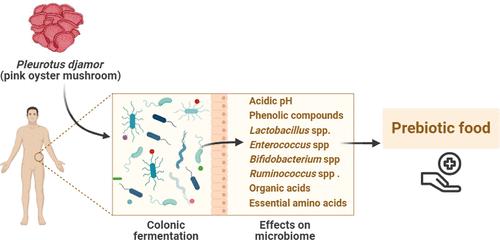揭示食用菌褶菌在体外结肠发酵过程中的潜在益生作用
IF 6.2
1区 农林科学
Q1 AGRICULTURE, MULTIDISCIPLINARY
引用次数: 0
摘要
食用菌调节肠道微生物群的能力是一个令人感兴趣的话题。本研究表明,在体外结肠发酵过程中,消化后的褶菌粉(MUS)表现出益生元效应。酚类化合物包括表儿茶素(3.03 ± 1.54 mg/L)、没食子酸(2.71 ± 1.54 mg/L)和槲皮素 3-葡萄糖苷(2.40 ± 1.54 mg/L)。在 48 个结肠发酵过程中,MUS 明显增加了乳酸杆菌属/肠球菌属(1.12% - 4.83%)、双歧杆菌属(0.59% - 1.85%)、白反刍球菌/R. flavefaciens(0.37% - 1.88%)的相对丰度,并减少了组织溶解梭菌(2.89% - 1.22%)。MUS 提高了乳酸和短链脂肪酸的产量,降低了 pH 值。1H NMR 分析显示,其中含有必需氨基酸、支链氨基酸和其他有益人体健康的化合物。这些结果表明了 P. djamor 对人体肠道微生物群的益生作用。本文章由计算机程序翻译,如有差异,请以英文原文为准。

Unveiling the Potential Prebiotic Effects of Edible Mushroom Pleurotus djamor During In Vitro Colonic Fermentation
The ability of edible mushrooms to modulate the intestinal microbiota is a topic of interest. This study shows that digested Pleurotus djamor powder (MUS) exhibits prebiotic effects during an in vitro colonic fermentation. Phenolic compounds, including epicatechin (3.03 ± 1.54 mg/L), gallic acid (2.71 ± 1.54 mg/L), and quercetin 3-glucoside (2.40 ± 1.54 mg/L), were found in P. djamor. MUS significantly increased the relative abundance of Lactobacillus spp./Enterococcus spp. (1.12% – 4.83%), Bifidobacterium spp. (0.59% – 1.85%), Ruminococcus albus/R. flavefaciens (0.37% – 1.88%), and reduced Clostridium histolyticum (2.89% – 1.22%) during 48 of colonic fermentation. MUS enhanced lactic acid and short-chain fatty acid production and decreased pH levels. The 1H NMR analysis revealed the presence of essential amino acids, branched-chain amino acids, and other compounds that benefit human health. The results indicate the prebiotic effects of P. djamor on human intestinal microbiota.
求助全文
通过发布文献求助,成功后即可免费获取论文全文。
去求助
来源期刊
CiteScore
9.90
自引率
8.20%
发文量
1375
审稿时长
2.3 months
期刊介绍:
The Journal of Agricultural and Food Chemistry publishes high-quality, cutting edge original research representing complete studies and research advances dealing with the chemistry and biochemistry of agriculture and food. The Journal also encourages papers with chemistry and/or biochemistry as a major component combined with biological/sensory/nutritional/toxicological evaluation related to agriculture and/or food.

 求助内容:
求助内容: 应助结果提醒方式:
应助结果提醒方式:


